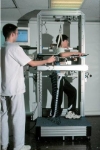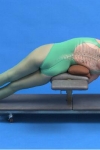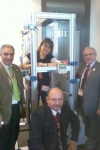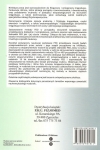FED Method - noinvasive treatment of scoliosis, kyphosis and lordosis.
Because of complicated and difficult problem of scoliosis treatment, indicating i.e. by lack of unified protocol when treating this diseases, the FED method, as its author describes himself: "three-dimensional spine stabilization with simultaneous extension and derotation" is an innovative approach to scoliosis therapy, gaining more and more supporters in Poland, Europe and around the world. Professor Santos Sastre Fernandez is the author of the method. FED method, originating from Spanish Fijación, Elongación, Desrotación; Fixation, Elongation, Derotation.
The method was created as a result of many years of scientific and research works and it is currently based on a large number of cataloged and confirmed clinical cases.
It is a complex proposition of lateral spinal deviation three-plane therapy (as well as for (hyper) kyphosis and lordosis), with prediction and determination of complete therapeutic management.
The treatment method suggested by Professor Sastre is based on the use of instrumental kinesitherapy, applied using specially developed and patented FED device which allows corrective forces to work at the deviation level through stabilization, stretching and derotation of the spine.
The method is based on the theory of growth, development, mutual effect and properties of cartilages: epiphyseal (physis) and neurocentral, present in the vertebral bodies, confirmed by numerous scientific studies and experiments. The method is more effective depending on earlier correct diagnosis of the patient and earlier beginning of therapy. Generally positive treatment effects should be expected in people with incomplete bone development. This method is well-tolerated by patients, even 6-year old children were subject to complete therapy.
Integral parts of the FED method include:
- Specialist test and diagnosis:
- FED test protocol containing a questionnaire and patient physical examination scheme.
- X-ray diagnostic imaging (in some cases even CT and MRI) performed so they would include possibly the entire spine, along with the pelvis and the hip joints. Precise analysis of scans with measurements, i.e. Cobb deformity angle, vertebral rotation angle (Rimondii), vertebral torsion, Risser sign, comparison of the hip joints and the sacroiliac joints, as well as performing a number of functional diagnostic tests.
- Classification and determining therapeutic procedures characteristic for every case and type of deformation.
- patient classification according to King-Moe classification (5 types of spinal deformations)
- selectio of appropriate therapy elements
- Physical preparation of the patient
- heat, used on the inside of the deformation curvatures
- electrostimulation, used on the outside of the deformation curvatures
- traction / elongation
- Therapy using FED device with particular focus on active autocorrection and proprioception.

 After taking position in the FED device, the patient is attached to a lifting system using a special harness in order to perform elongation, as well as reduce strain (in 80% of cases) of the spine. Next, appropriate patient setting and stabilization are performed using stabilizers. Corrective force is applied on the apex of the deformation curvature through remotely controlled actuator. The values of the pressure force (the corrective force) which could be applied to patients are starting from a dozen or so, up to 100 kg. Therapeutic effect depends on the size of applied load, yet the goal is to achieve the highest values for the specific patient, as quickly as possible. The pressure is applied during a dozen or so seconds or a few dozen seconds of sets, after which there are relax periods (pressure release). When relaxing, the patient actively maintains position which he/she was able to achieve through corrective force action. When we face scoliosis with two or even more curvatures, then each deformation curvature has to be managed individually. It is worth noting the fact that even proportionally high pressure force is well tolerated by patients. The therapy using the device takes approx. 30 minutes.
After taking position in the FED device, the patient is attached to a lifting system using a special harness in order to perform elongation, as well as reduce strain (in 80% of cases) of the spine. Next, appropriate patient setting and stabilization are performed using stabilizers. Corrective force is applied on the apex of the deformation curvature through remotely controlled actuator. The values of the pressure force (the corrective force) which could be applied to patients are starting from a dozen or so, up to 100 kg. Therapeutic effect depends on the size of applied load, yet the goal is to achieve the highest values for the specific patient, as quickly as possible. The pressure is applied during a dozen or so seconds or a few dozen seconds of sets, after which there are relax periods (pressure release). When relaxing, the patient actively maintains position which he/she was able to achieve through corrective force action. When we face scoliosis with two or even more curvatures, then each deformation curvature has to be managed individually. It is worth noting the fact that even proportionally high pressure force is well tolerated by patients. The therapy using the device takes approx. 30 minutes.


Examples of FED analytical kinesitherapy exercises.
- Analytical Kinesitherapy
- includes specially selected procedures - exercise sets - therapeutic
- one, applied in case of specific types of deformity according to King-Moe
- Supporting Methods
- Kinesitherapy, e.g. PNF, kinesiology taping, swimming
- Orthopedic Support, Braces
- in some cases orthopedic support using Cheneau-type brace is used
- as a supplement to the FED therapy
- Periodic control and assessment of improvement results:
- FED examination protocol
- DIERS diagnostics
- comparison through diagnostic X-ray imaging (CT, MRI)
The FED method program is conducted as a part of therapeutic camps, during which the patient undergoes complete cycle of treatments, with the therapy in FED unit/device used once, and in some specific cases even twice per day. You should take part in such a camp as often as possible, at least once every six months or in some cases even once every quarter of year. During the period between camps, we continue the therapy at home, based on taught analytical kinesitherapy FED protocols and available kinesitherapy or supporting methods. If possible, it is advised to use outpatient procedures with FED device as often as possible.
FED therapy program may also be conducted as a part of outpatient procedures, where the most important elements of the therapy are regularity and frequency. We use as many treatments as possible.
It is worth noting the fact that the FED method is open to other methods of treatment. Even when it comes to its assumptions, the method introduces physical stimuli, swimming and orthopedic support to therapy. It allows - as a supplement - the use of other methods such as Kinesiology Taping (KT) oraz PNF.



Case description: Results achieved in a 12-year old patient over 18 months. The program included two sessions per week using the FED device and daily exercises according to FED analytical kinesitherapy.
12 year old girl PIS. FED treatment 2 sessions per week and physiotherapy at home. Evolution:
X-ray 06/2003 T11-L4 26º Cobb Risser 0 Raimondi L2 10º
X-ray 01/2004 T11-L4 19º Cobb Risser 1,5 Raimondi 8º
X-ray 11/2004 T11-L4 15º Cobb Risser 2,5 Raimondi 3º

International FED Method Team
(From the left: ) Prof. Santos Sastre , Mgr Berenika Żuk, Mgr Marek Wiecheć, Prof. Zbigniew Śliwiński during International Spinal Surgery Conference in Zakopane, in 2010.
 Home
Home













